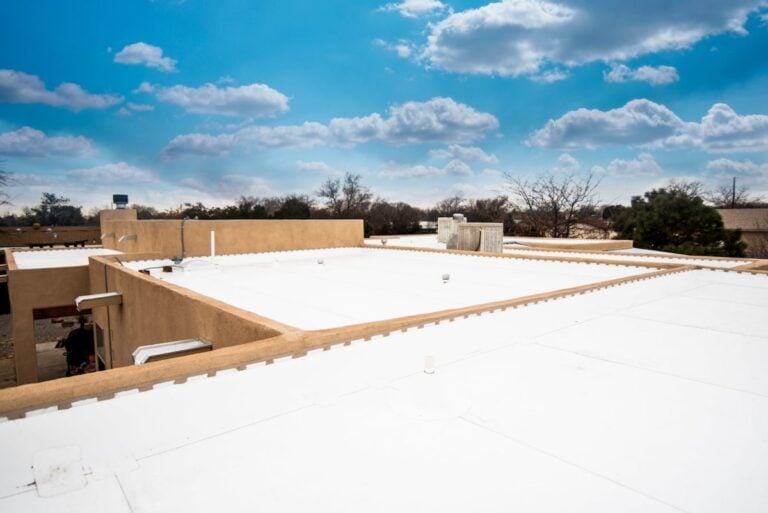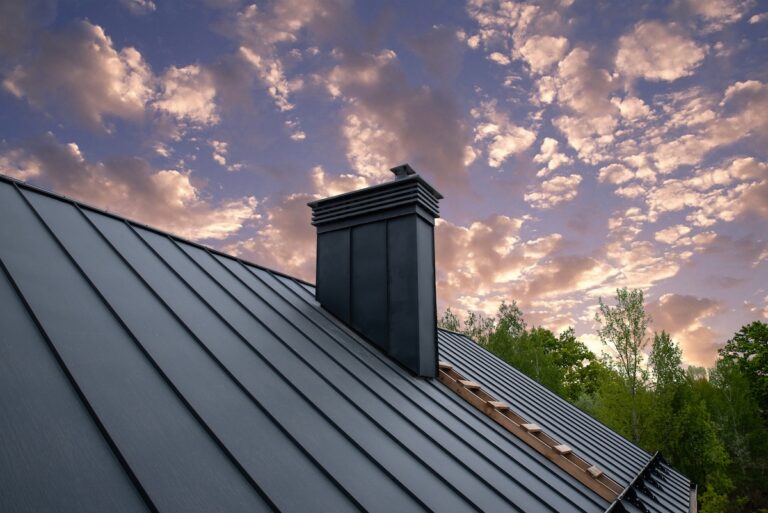What Is TPO Roofing? (Material, Durability, & More)
If you’ve spent any time researching roofing options for your home or commercial property, you may have come across the term “TPO roofing.” But what exactly is it, and why is it gaining so much popularity?
This blog will break down everything you need to know about TPO roofing, including its material composition, durability, benefits, and why it’s an increasingly popular choice for both residential and commercial buildings.
Here’s what this guide covers:
- What is TPO roofing?
- The advantages of TPO roofing (including a numbered list)
- Where is TPO roofing used?
What Is TPO Roofing?

Thermoplastic Polyolefin (TPO) roofing is a single-ply roofing membrane commonly used for low-slope or flat roofs. Made of a blend of ethylene-propylene rubber and other materials, TPO strikes the perfect balance between reliability, affordability, and energy efficiency.
Unlike traditional roofing options like asphalt shingles or tar-and-gravel systems, TPO offers a streamlined and modern solution tailored for optimal performance. Its light-colored surface is designed to reflect sunlight, which makes TPO excellent for maintaining energy-efficient buildings.
Here are the primary components of TPO roofing:
- Durable Membrane: Resistant to tearing, puncturing, and UV damage.
- Heat-Welded Seams: Stronger and more leak-resistant than glued seams in other systems.
- Eco-Friendly Materials: Many TPO roofs are recyclable and sustainable.
6 Advantages of TPO Roofing

Wondering what makes TPO such a standout option? Here are the top benefits:
1. Energy Efficiency
TPO roofing is designed with a reflective surface that minimizes heat absorption, making it an excellent choice for keeping buildings cooler during warmer months. This reduction in heat absorption leads to lower cooling costs, making it an energy-efficient option for commercial and residential buildings alike. For those focused on sustainability, TPO’s energy efficiency can also contribute to achieving LEED certification, which recognizes buildings that meet certain standards for environmental responsibility and energy performance.
2. Durability
TPO membranes are built to last, offering resistance against various forms of damage, including UV exposure, tears, mold growth, and chemical corrosion. Their durability makes them an ideal choice for regions that experience harsh weather conditions. Whether it’s heavy rainfall, high winds, or extreme temperature changes, TPO roofs remain resilient and maintain their performance over time, providing long-term protection for the building.
3. Cost-Effective
Despite its impressive performance and range of benefits, TPO remains one of the most cost-effective roofing materials available. When considering TPO vs PVC roofing, many building owners find that TPO offers a more affordable entry point without sacrificing essential qualities. TPO combines affordability with impressive durability and energy efficiency, making it a high-value option for flat or low-slope roofs. Its ease of installation can also contribute to lower labor costs, further maximizing your roofing investment without overspending.
4. Low Maintenance
TPO roofs are designed to require minimal maintenance, which is a significant advantage for property owners. Thanks to their excellent water resistance, TPO roofs are less prone to leaks and water-related damage. Additionally, the material’s inherent strength reduces the risk of cracking, tearing, or other forms of deterioration, allowing building owners to spend less time and money on upkeep compared to other roofing materials.
5. Eco-Friendly Option
For environmentally conscious builders and property owners, TPO roofing is an eco-friendly choice. Many TPO membranes are manufactured without harmful chemicals, which reduces their environmental impact during production. Moreover, TPO roofing is fully recyclable at the end of its lifespan, ensuring that old materials can be repurposed rather than ending up in landfills. This makes TPO a sustainable option for those aiming to reduce their carbon footprint.
6. Fast Installation
TPO features a single-ply design that simplifies the installation process, allowing it to be applied quickly and efficiently. This streamlined installation reduces the amount of labor required, which in turn lowers labor costs and shortens project timelines. The ease of installation means that building projects can be completed faster without sacrificing the quality or performance of the roofing system. Despite being an easy-to-install roof, remember that only professional roofers can guarantee long-term durability.
Where Is TPO Roofing Used?

TPO is one of the most widely-used roofing materials for commercial properties, especially those with flat or low-slope roofs. However, it’s also becoming a popular choice for residential properties with similar roof designs.
Retail Buildings
Retail buildings frequently opt for TPO roofing because of its outstanding energy-efficient properties. The reflective surface of TPO membranes minimizes heat absorption by reflecting the sun’s rays, which significantly reduces internal building temperatures. This leads to lower cooling costs, especially in warmer climates, helping businesses save on energy expenses.
Additionally, maintaining a cooler and more comfortable indoor environment benefits both shoppers and employees, improving customer satisfaction and workplace productivity. TPO roofing is also associated with sustainability, as its energy efficiency aligns with the growing trend of environmentally conscious business practices. For retail businesses looking to enhance their green credentials while cutting operational costs, TPO roofing is a smart and practical investment.
Warehouses and Industrial Facilities
Warehouses and industrial facilities often require roofing that is tough, reliable, and low-maintenance, making TPO roofing an excellent option. While TPO is a popular choice, it’s important to remember that there are other different types of flat roof materials, such as PVC and EPDM, each with its own benefits. These spaces are subject to demanding conditions, including exposure to harsh weather, temperature fluctuations, and continuous wear and tear from operations and equipment.
TPO membranes are known for their puncture resistance, flexibility, and ability to withstand extreme weather conditions, such as heavy rain, hail, and snow. The material also resists chemical exposure, which is particularly useful in industrial environments. Furthermore, TPO roofing requires minimal upkeep, saving time and resources for facility managers. Its long lifespan and cost-effectiveness make it a valuable solution for large-scale facilities that prioritize durability and operational efficiency.
Residential Properties
TPO roofing is becoming increasingly popular for residential properties, particularly those with flat or minimalist roof designs. Homeowners are drawn to TPO for its eco-friendly characteristics, as the material is recyclable and contributes to reduced energy consumption. The reflective surface of TPO reduces heat buildup, which keeps homes cooler in the summer and lowers air conditioning costs. Additionally, TPO roofing offers a sleek, clean look that complements modern architectural styles, making it a desirable choice for contemporary homes.
Its affordability adds to its appeal, offering budget-conscious homeowners a reliable roofing option without sacrificing quality. For those looking to reduce their environmental footprint and enhance their home’s energy efficiency, TPO provides the perfect balance of style, functionality, and sustainability.
TPO roofing’s combination of versatility, reliability, and energy efficiency has solidified its position as a top choice for builders and property owners across various industries.
Find the Perfect Flat Roofing Solution
TPO roofing offers the perfect combination of durability, cost-effectiveness, and energy efficiency, making it an excellent choice for both residential and commercial properties. Its growing popularity is no surprise, given how well it performs under the sun, wind, and rain. For a top-quality TPO installation from professional roofers in Albuquerque, our experienced team, high-quality materials, and commitment to customer satisfaction will ensure a roofing system that will stand the test of time.
If you’re considering a TPO roof for your home or business, trust Cabezon Roofing to handle the job with precision and care. With our experienced team, high-quality materials, and commitment to customer satisfaction, you’re guaranteed a roofing system that will stand the test of time.



